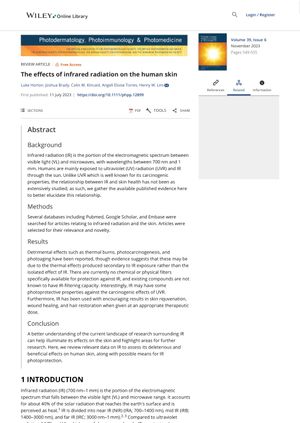The Effects of Infrared Radiation on the Human Skin
July 2023
in “
Photodermatology, Photoimmunology and Photomedicine
”

TLDR Infrared radiation can cause skin aging and cancer at high temperatures but may have therapeutic benefits at controlled levels.
Infrared radiation (IR), which constitutes about 40% of solar radiation reaching Earth, can penetrate deeper into the skin than ultraviolet radiation and visible light. While traditionally linked to photoaging and photocarcinogenesis, recent studies suggest potential benefits. Chronic IR exposure can lead to skin wrinkling and erythema ab igne, potentially transforming into squamous cell carcinoma or Merkel cell carcinoma. These effects are mediated by activator protein 1 (AP-1) and matrix metalloproteinase (MMP) gene. However, harmful effects of IR appear only at temperatures outside the normal physiological range. Low irradiance and controlled temperature IR can provide protection against skin cancer, and be used therapeutically for skin rejuvenation, wound healing, hair restoration, and pain control. The exact parameters for the "therapeutic range" of IR need further research. Adding antioxidants to sunscreen may offer some protection against IR, but the need for this protection is debated.







